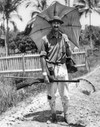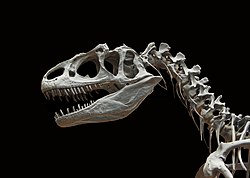|
The Palaeontology Portal
Introduction Paleontology ( /ˌpeɪliɒnˈtɒlədʒi, ˌpæli-, -ən-/ PAY-lee-on-TOL-ə-jee, PAL-ee-, -ən-), also spelled palaeontology or palæontology, is the scientific study of life that existed prior to, and sometimes including, the start of the Holocene epoch (roughly 11,700 years before present). It includes the study of fossils to classify organisms and study their interactions with each other and their environments (their paleoecology). Paleontological observations have been documented as far back as the 5th century BC. The science became established in the 18th century as a result of Georges Cuvier's work on comparative anatomy, and developed rapidly in the 19th century. The term has been used since 1822 formed from Greek παλαιός ('palaios', "old, ancient"), ὄν ('on', ( gen. 'ontos'), "being, creature"), and λόγος ('logos', "speech, thought, study"). Paleontology lies on the border between biology and geology, but it differs from archaeology in that it excludes the study of anatomically modern humans. It now uses techniques drawn from a wide range of sciences, including biochemistry, mathematics, and engineering. Use of all these techniques has enabled paleontologists to discover much of the evolutionary history of life, almost all the way back to when Earth became capable of supporting life, nearly 4 billion years ago. As knowledge has increased, paleontology has developed specialised sub-divisions, some of which focus on different types of fossil organisms while others study ecology and environmental history, such as ancient climates. ( Full article...) Selected article on the prehistoric world and its legacies
Megalodon (
/ˈmɛɡələdɒn/
MEG-ə-lə-don; meaning "big tooth", from
Ancient Greek: μέγας,
romanized: (megas),
lit. 'big, mighty' and ὀδoύς (odoús), "tooth"—whose stem is odont-, as seen in the
genitive case form ὀδόντος, odóntos) is an
extinct
species of
shark that lived approximately 15.9 to 2.6
million years ago, during the
Cenozoic
Era (middle
Miocene to end of
Pliocene).
The taxonomic assignment of C. megalodon has been debated for nearly a century, and is still under dispute. The two major interpretations are Carcharodon megalodon (under family Lamnidae) or Carcharocles megalodon (under the family Otodontidae). Consequently, the scientific name of this species is commonly abbreviated C. megalodon in the literature. C. megalodon is regarded as one of the largest and most powerful predators in vertebrate history, and likely had a profound impact on the structure of marine communities. Fossil remains suggest that this giant shark reached a maximum length of 18 metres (59 ft), and also affirm that it had a cosmopolitan distribution. Scientists suggest that C. megalodon looked like a stockier version of the great white shark, Carcharodon carcharias. ( see more...) Did you know?

General images -The following are images from various paleontology-related articles on Wikipedia.
Selected article on paleontology in human science, culture and economics
William Beebe was an
American
naturalist,
ornithologist,
marine biologist,
entomologist,
explorer, and
author. He is remembered for the numerous expeditions he conducted for the
New York Zoological Society, his deep dives in the
Bathysphere, and his prolific
scientific writing for both academic and popular audiences.
Born in Brooklyn, New York Beebe left college before obtaining a degree in order to work at the then newly opened New York Zoological Park, where he was given the duty of caring for the zoo's birds. Beebe participated in a series of research expeditions, including one intended to document the world's pheasants. He published an account of his pheasant expedition titled A Monograph of the Pheasants. During the course of his expeditions Beebe gradually developed an interest in marine biology, ultimately leading to his 1930s dives in the Bathysphere off the coast of Bermuda. These dives represented the first time a biologist observed deep-sea animals in their native environment. Later, Beebe returned to the tropics and founded a tropical research station which remains in operation as part of the Asa Wright Nature Centre. Beebe's research there continued until his death in 1962. He is also remembered for several theories he proposed about avian evolution which are now regarded as having been ahead of their time, particularly his 1915 hypothesis that the evolution of bird flight passed through a four-winged or "Tetrapteryx" stage, which has been supported by the 2003 discovery of Microraptor gui. ( see more...) On this day...April 23:
Imperfect Isolation: Factors and Filters Shaping Madagascar’s Extant Vertebrate Fauna Karen E. Samonds, Laurie R. Godfrey, Jason R. Ali, Steven M. Goodman, Miguel Vences, Michael R. Sutherland, Mitchell T. Irwin, David W. Krause published 23 Apr 2013 Selected image
CategoriesTopicsGeneral -
Paleontology -
Fossil -
Evolution -
Extinction Quality ContentFeatured paleontology articles
-
Achelousaurus
-
Acrocanthosaurus
-
Albertosaurus
-
Allosaurus
-
Amargasaurus
-
Ankylosaurus
-
Apatosaurus
-
Archaeopteryx
-
Baryonyx
-
Carnotaurus
-
Catopsbaatar
-
Ceratosaurus
-
Chicxulub Crater
-
Compsognathus
-
Cretaceous–Tertiary extinction event
-
Daspletosaurus
-
Deinocheirus
-
Deinonychus
-
Deinosuchus
-
Dilophosaurus
-
Dinosaur
-
Diplodocus
-
Dromaeosauroides
-
Edmontosaurus
-
Elasmosaurus
-
Giganotosaurus
-
Gorgosaurus
-
Herrerasaurus
-
Iguanodon
-
Istiodactylus
-
Lambeosaurus
-
List of dinosaur genera
-
Majungasaurus
-
Massospondylus
-
Megalodon
-
Nemegtomaia
-
Nigersaurus
-
Opisthocoelicaudia
-
Paranthodon
-
Parasaurolophus
-
Plateosaurus
-
Psittacosaurus
-
Seorsumuscardinus
-
Spinosaurus
-
Stegosaurus
-
Stegoceras
-
Styracosaurus
-
Tarbosaurus
-
Thescelosaurus
-
Triceratops
-
Tyrannosaurus
-
Velociraptor
Things you can doCurrent Paleontology FACs - None yet... WikiProjectsRelated portalsAssociated WikimediaThe following Wikimedia Foundation sister projects provide more on this subject:
Discover Wikipedia using
portals |








































